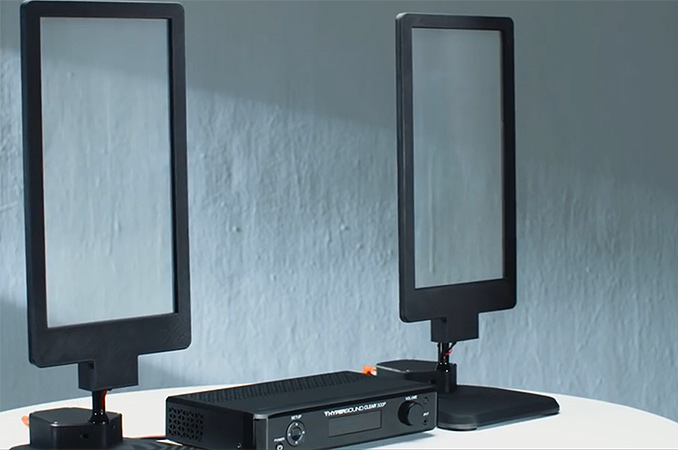Turtle Beach Demos HyperSound Glass: Transparent Speakers Made of Glass
by Anton Shilov on June 28, 2016 6:00 PM EST- Posted in
- Speakers
- Turtle Beach
- HyperSound

Turtle Beach has announced that it had built its first transparent directional speakers featuring its HyperSound technology. The company demonstrated an early prototype of the speaker set publicly at the E3 trade show, but does not reveal when it expects the new tech to be commercialized.
Turtle Beach’s HyperSound Glass is comprised of multiple layers of thin transparent films, which can generate a narrow beam of ultrasound (high frequency sound) that delivers audio to a targeted listener (by the time it reaches the targeted spot, ultrasound becomes normal sound) and does not disturb others. Since the speakers produce ultrasound, the audio is inaudible in a very short distance from the speakers and is also claimed to be imperceptible in locations outside of the targeted area. To generate that beam, Turtle Beach uses the HyperSound software technology, which the company already commercializes, but not with glass. According to Turtle Beach, the sound generated by its films maintains clarity over longer distances than traditional loudspeakers (which may well be correct given the size of the “driver”), but the company does not reveal technical specifications of its devices, such as frequency response or wattage.
As pointed out above, the HyperSound tech is not something completely new. At present, Turtle Beach offers its HyperSound Clear 500P speaker system for those with hearing problems and their families. The HyperSound Clear 500P do not feature transparent speakers, but can beam loud audio to a specific spot, whereas those around will hear normal volume audio. The product does not use glass/films, but a special metallic grill to produce ultrasound.
Turtle Beach claims that the HyperSound Glass could be integrated into various monitors, desktop speakers, and automotive dashboard glass to deliver sounds to specific listeners. Turtle Beach does not plan to build products based on the HyperSound technology exclusively itself, but can license it to others.
The HyperSound Glass technology is still work in progress and we have no idea when this tech could be commercialized. Nonetheless, since Turtle Beach showed off prototypes at E3, it is highly likely that the technology is nearly ready.
Source: Turtle Beach










21 Comments
View All Comments
woggs - Wednesday, June 29, 2016 - link
It's surprisingly difficult to find any details of the physics involved. The only thing I can find is the ted talk which hints at it using very high frequency sound at very high volumes to make use of non-linear but predictable properties of air. I have no clue what that really means. The means by which "ultrasound becomes normal sound" is not described anywhere that I can find.webdoctors - Tuesday, June 28, 2016 - link
This is huge. Its like Crystal Pepsi huge! Definitely gonna change the world. NOT!JoeyJoJo123 - Wednesday, June 29, 2016 - link
+1bug77 - Wednesday, June 29, 2016 - link
And again no mention of fidelity or dynamic range.Murloc - Sunday, July 3, 2016 - link
because anyone who cares about this stuff is going to buy traditional speakers.russki - Wednesday, June 29, 2016 - link
I guarantee these will sound like absolute garbage.BurntMyBacon - Wednesday, June 29, 2016 - link
Why is it that every time I see something new in the HyperSound realm, I immediately get premonitions of loud (think infomercial), targeted ADs assaulting me individually from store fronts as I walk down the commercial district of any major city?fanofanand - Wednesday, June 29, 2016 - link
I had not even considered that, but the thought sends a shiver through my bones......Murloc - Sunday, July 3, 2016 - link
I bet that's illegal in many countries due to noise ordnances, would probably be banned quickly where it's not illegal.FunBunny2 - Wednesday, June 29, 2016 - link
been around for ages, here: https://en.wikipedia.org/wiki/Sound_from_ultrasoun..."F. Joseph Pompei of MIT developed technology he calls the "Audio Spotlight",[6] and made it commercially available in 2000 by his company Holosonics, which according to their website claims to have sold "thousands" of their "Audio Spotlight" systems. Disney was amongst the first major corporations to adopt it for use at the Epcot Center, and many other application examples are shown on the Holosonics website."